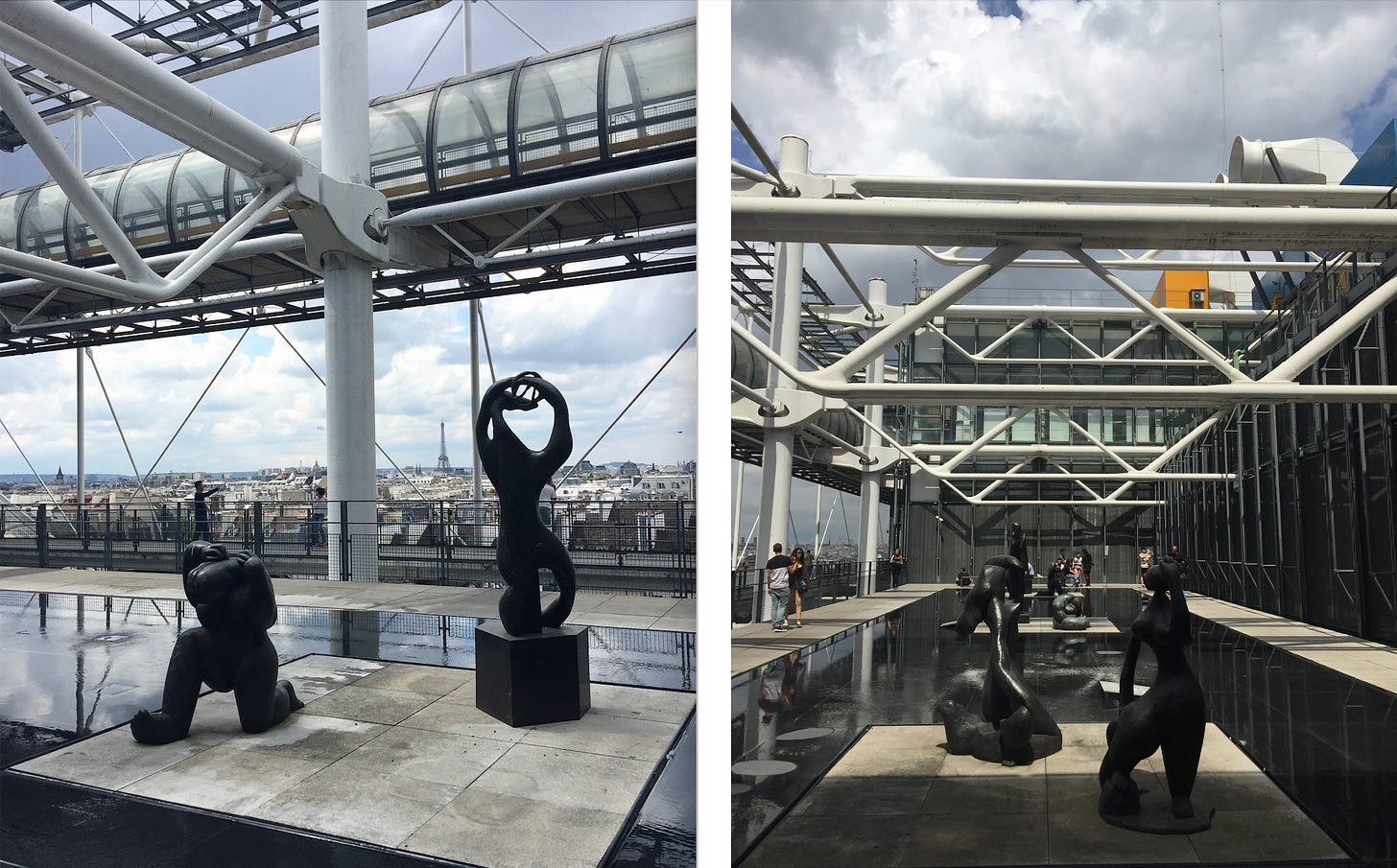Centre Pompidou / Paris, France
Why to visit the iconic museum in the 4th arrondissement before it closes for renovation in 2025
Centre Pompidou
Paris is an art lovers dream, a city you wouldn’t dare visit without experiencing at least one great masterpiece. While most people usually choose to glimpse the Mona Lisa at the Louvre—a solid decision, by the way—any fans of modern art and architecture should add the Centre Pompidou to the top of their list.
Particularly right now. Rarely is there an urgency to visit a museum—these storied institutions are typically reliable in their commitment to being open. But the Pompidou is about to close for a 5-year renovation starting in 2025, its iconic caterpillar and industrial structure in serious need of repair. And before closing up shop, they are going out with a momentous bang with the opening of a landmark exhibition marking the 100th anniversary of Surrealism. This exhibition, designed like a maze, dazzles with paintings by Dali and Magritte, Ernst and de Chirico. It’s already receiving critical praise, a triumph in furthering the understanding of the Surrealist movement’s origins, influences and artistic legacy, and thus a fitting bookmark before Paris bids a temporary farewell to this iconic structure.
So what’s the story behind the Pompidou?
Located in one of Paris’ oldest districts, the 4th Arrondissement, the Pompidou was built in 1977 to house the Musée national d’art moderne. Designed by now famed architects Renzo Piano and Richard Rogers, the museum was conceived as a living organism. They literally wanted visitors to feel like they were seeing the insides of a building, its arteries and organs and bones. Bright primary colors are used to signal function, with all the systems located on the outside of the building. Blue is for air flow (i.e. air conditioners), yellow electricity, green represents water circuits, and red is for pedestrian flow (escalators and lifts).
While its unveiling in 1977 was heralded as an architectural feat by artistic circles, it took Parisians time to fall in love with this radically new vision of a museum. Initially it was lamented as a blight on the skyline, monstrous, like a spaceship, nicknamed the “Notre Dame of the Pipes.” But over time, the public fell in love with this uniquely experimental space that offered a contrast to the traditional monuments scattered throughout the city. And while it certainly looked different on the outside, the Pompidou’s interior still offered blank canvases to emphasis what visitors should come to see: extraordinary art of the 20th century from artists including Marcel Duchamp, Henri Matisse, Frida Kahlo and Joan Miró. A true embodiment of how architecture can enhance and influence the experience of viewing art, the Pompidou embraces modernism in all its strange and powerful manifestations.
Visitor Notes:
The Pompidou has one of the best views of Paris. Don’t skip out on visiting the roof deck with its phenomenal sculpture garden. And if you’re hungry, book a table for lunch to take it all in over a glass of wine.
When planning your trip, be sure to review the different access points into the museum (although it’s a pretty cool experience if you’re forced to walk around the entire building).
Artx2: Musée National Picasso-Paris
A short 12-minute walk away through the Marais neighborhood is the Musée National Picasso-Paris, its architecture quite literally the opposite experience of the Pompidou. Located in a historic mansion built in the 1650s, the museum is dedicated to the life and work of Pablo Picasso and the French artists connected to him. With over 5,000 works by Picasso, tens of thousands of archival objects, and the artist’s own personal collection of art, the museum is a breathtaking dedication to the prolific artist and the city he called home for decades.
Let’s Eat + Drink

Boulangeries to Bookmark
It goes without saying that Paris is known for its bakeries. Expect to eat baguettes and croissants and as many macaroons as you possibly can. With over 1,300 boulangeries located across the city, the best advice is to ask a local where the tastiest spot is near where you’re staying. Grab whatever pastry calls to you, sit outside with a warm cup of coffee and watch as the city begins its day.
But if you’re strolling through the Marais neighborhood on your afternoon at the Pompidou, be sure to bookmark these three spots for an exemplary experience:
Brigat’ — a bakery known for their cloudy brioche and inventive fruit tarts
Petite Île — pain au chocolat with a Japanese twist
Pierre Herme — macaroons, macaroons, macaroons
Crepe Lunch: L'Épicerie du Breizh Café
If crepes are what bring you to Paris, then you’re almost required to visit L'Épicerie du Breizh Café. While it’s no longer a local secret (aka expect lines and tourists), the innovative crepes make it worth it. Whether you are more of a savory or sweet fan, prepare to be dazzled.
Classic Bistro Lunch: Parcelles
This bistro à vins opened in 2021 and is still the talk of the Marais. Serving a modern take on French classics, expect to find a chalkboard menu listing the daily specialities, with items like fresh clams or braised beef cheeks. With an outstanding wine list, this is the spot to enjoy a leisurely meal after a day of great art.
Memorable Dinner: Carboni’s
Make sure to book a reservation for this cozy restaurant where every dish has an element of fire. Serving modern Italian dishes (i.e. lots of fresh pasta), don’t come here if you are gluten-free or don’t appreciate a little char. This is the spot for a romantic dinner for two or an evening out with close friends who don’t mind splitting a bowl of pasta.

Resources

The Centre Pompidou produces great podcasts in English and French to prepare you for your visit.
If you need to freshen up on the history of surrealism before your visit, be sure to read this great overview from The Art Story.







